Hirundo abyssinica (Lesser
striped swallow)
Kleinstreepswael [Afrikaans]; Inkonjane (generic term for
swallows) [Xhosa]; iNkonjane (generic term for swallows) [Zulu]; Sisampamema
(generic term for swallows, martins, swifts and spinetails) [Kwangali];
Nyenganyenga (generic name for swallow or martin) [Shona]; Nyengha (generic term
for swallow) [Tsonga]; Pêolwane, Phêtla (generic terms for swifts, martins and
swallows) [Tswana]; Savanne-zwaluw [Dutch]; Hirondelle striée [French]; Kleine
streifenschwalbe [German]; Andorinha-estriada-pequena [Portuguese]
Life
> Eukaryotes >
Opisthokonta
> Metazoa (animals) >
Bilateria >
Deuterostomia > Chordata >
Craniata > Vertebrata (vertebrates) > Gnathostomata (jawed
vertebrates) > Teleostomi (teleost fish) > Osteichthyes (bony fish) > Class:
Sarcopterygii (lobe-finned
fish) > Stegocephalia (terrestrial
vertebrates) > Tetrapoda
(four-legged vertebrates) > Reptiliomorpha > Amniota >
Reptilia (reptiles) >
Romeriida > Diapsida > Archosauromorpha > Archosauria >
Dinosauria
(dinosaurs) > Saurischia > Theropoda (bipedal predatory dinosaurs) >
Coelurosauria > Maniraptora > Aves
(birds) > Order: Passeriformes
> Family: Hirundinidae
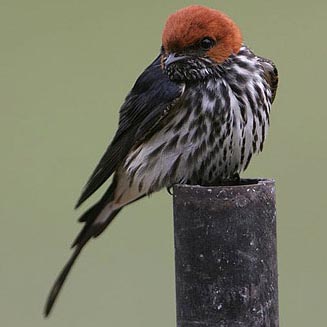 |
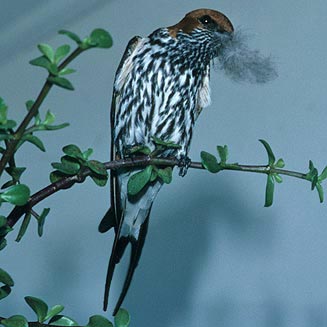 |
|
Lesser striped swallow, Mkuze Game Reserve, South
Africa. [photo Trevor Hardaker ©] |
Lesser striped swallow collecting nest material.
[photo H. Robertson, Iziko ©] |
Distribution and habitat
It occurs across much of sub-Saharan Africa from Guinea and
Ethiopia down to southern Africa. Here it is common in the eastern half of the
region, including Zimbabwe, Mozambique, northern and eastern Botswana, Kruger
National Park, Swaziland, KwaZulu-Natal and the Eastern Cape. It generally
favours open habitats such as grassland, savanna, forest edges and clearings,
open water (e.g. over a lake), gallery forest, rural settlements and cultivated
land.
|
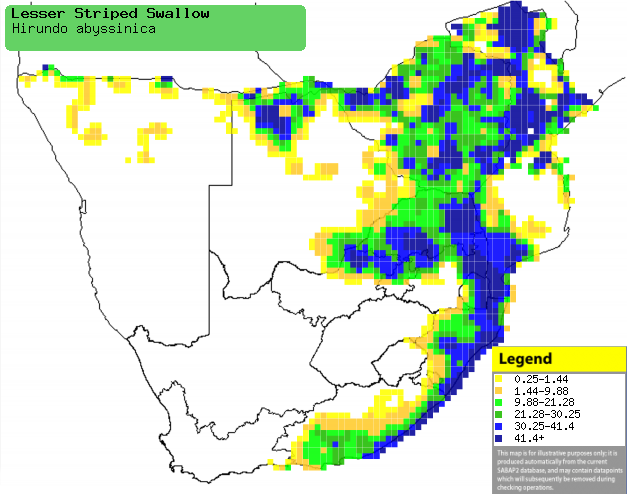 |
|
Distribution of Lesser striped swallow in southern
Africa, based on statistical smoothing of the records from first SA Bird
Atlas Project (©
Animal Demography unit, University of
Cape Town; smoothing by Birgit Erni and Francesca Little). Colours range
from dark blue (most common) through to yellow (least common).
See here for the latest distribution
from the SABAP2. |
Food
It mainly eats arthropods, supplemented occasionally with
fruit and seeds. Most foraging is done aerially, but it may descend onto a tree
to feed on fruit or seeds, flapping its wings to balance. The following food
items have been recorded in its diet:
- Insects
- Trema orientalis (Pigeonwood) fruit
- Acacia cyclops (Rooikrans) seeds
Breeding
- Both sexes construct the nest (see images below), which is a bowl built of
mud pellets and lined with grass and feathers. It is often placed in a
man-made structure, such as a building or bridge, but it can also be
positioned under a rock overhang or cavity in a branch or trunk of a tree.
The same nest site used over multiple breeding seasons, each year it is
either rebuilt or repaired before the eggs are laid.
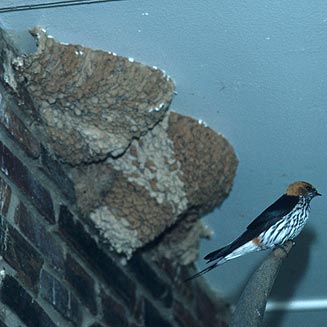 |
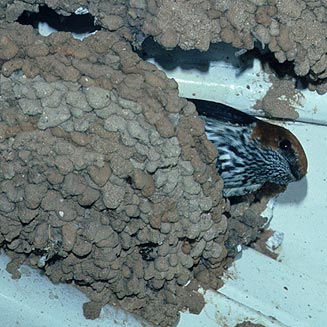 |
| Lesser striped swallow, perching in
and next
to its nest. [photos H. Robertson, Iziko ©] |
- Laying dates vary greatly over its distribution, but egg-laying season is
mainly from October-May.
- It lays 2-4, usually 3 eggs, which are incubated solely by the female
for 14-21 days.
- The chicks are fed regularly, leaving the nest after approximately 17-18
days. The fledglings are still dependent on their parents for 3-4 more
weeks, roosting in their nest and eating the food brought to them.
Threats
Not threatened.
References
-
Hockey PAR, Dean WRJ and Ryan PG 2005. Roberts
- Birds of southern Africa, VIIth ed. The Trustees of the John Voelcker
Bird Book Fund, Cape Town.
|
